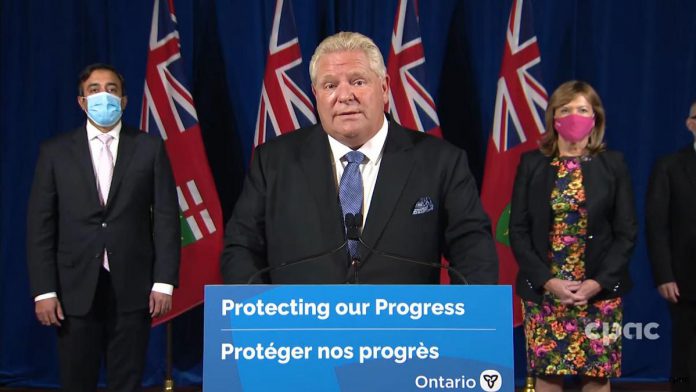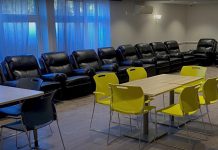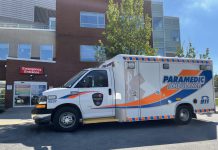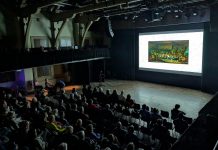
The Ontario government has unveiled its plan to gradually lift remaining COVID-19 public health and workplace safety measures by March 2022, beginning Monday (October 25) by removing capacity restrictions and physical distancing requirements in additional indoor settings where proof of vaccination is required, including restaurants, bars, gyms, casinos, indoor meeting and event spaces, and more.
On October 25, the government will also allow other indoor settings where proof of vaccination is not required — including personal care services, museums, galleries, real estate open houses, photography studios, and more — to lift capacity limits and physical distancing requirements if they choose to require proof of vaccination.
The government also announced it intends to allow for greater capacity at organized public events, such as Remembrance Day ceremonies and Santa Claus parades, with more details to be provided in the near future.
“We can see the end of this pandemic in sight, but it’s not over yet,” Premier Doug Ford said at a media conference at Queen’s Park on Friday (October 22). “We can’t get too comfortable or let our guard down, but we’re going to be able to begin getting back to the lives we want.”
During the reopening plan, the government says it will continue to monitor key public health and health care indicators — including any new COVID-19 variants, increases in hospitalizations and ICU occupancy, and rapid increases in transmission — to ensure that public health and workplace safety measures are lifted safely.
“While we are optimistic about the future, the province will continue to monitor the situation very closely, and we will respond quickly to protect Ontarians’ health should the need arise,” said Dr. Kieran Moore, Ontario’s chief medical officer of health.
“To manage COVID-19 over the long term, local and regional responses will be implemented based on local context and conditions,” Dr. Moore added. “Public health measures would be applied provincially in exceptional circumstances, such as when the province’s healthcare system capacity is at risk of becoming overwhelmed, or if a vaccine-resistant COVID-19 variant is ever identified in the province.”
Additional lifting of restrictions would continue on November 15, when capacity limits will be removed in other indoor settings where proof of vaccination is required, including food or drink establishments with dance facilities (including night clubs and wedding receptions in meeting or event spaces where there is dancing), strip clubs, bathhouses, and sex clubs.
The province intends to lift additional restrictions beginning in the new year, unless there are “concerning trends” in public health and health care following the winter holiday months and after students return to in-class learning.
“If we do not see the numbers in a stable place, we just aren’t going to do it,” Ford said, with Dr. Moore adding the province will review the data for the previous two months before lifting additional restrictions beginning January 17.
As of that date, the province will begin lifting capacity limits in settings where proof of vaccination is not required, and may also gradually lift the proof of vaccination requirements for restaurants, bars, and other food and drink establishments, facilities used for sports and recreational facilities, and casinos, bingo halls, and other gaming establishments.
On February 7, the province will lift proof of vaccination requirements in high-risk settings, including night clubs, strip clubs, and bathhouses and sex clubs.
On March 28, the province will lift remaining public health and workplace safety measures, including wearing face coverings in indoor public settings, and will remove the proof of vaccination requirement for all remaining settings, including meeting and event spaces, sporting events, concerts, theatres and cinemas, racing venues, and commercial and film productions with studio audiences.
Full details of the province’s plan and milestone dates are provided below.
October 25, 2021
Efective October 25, 2021 at 12:01 a.m., Ontario will lift capacity limits in the vast majority of settings where proof of vaccination are required, such as restaurants, bars and other food or drink establishments; indoor areas of sports and recreational facilities such as gyms and where personal physical fitness trainers provide instruction; casinos, bingo halls and other gaming establishments; and indoor meeting and event spaces. Limits will also be lifted in certain outdoor settings.
At this time, the government will also allow other settings to lift capacity limits and physical distancing requirements if they choose to require proof of vaccination, including:
- Personal care services (e.g., barber shops, salons, body art);
- Indoor areas of museums, galleries, aquariums, zoos, science centres, landmarks, historic sites, botanical gardens and similar attractions;
- Indoor areas of amusement parks;
- Indoor areas of fairs, rural exhibitions, festivals;
- Indoor tour and guide services;
- Boat tours;
- Indoor areas of marinas and boating clubs;
- Indoor clubhouses at outdoor recreational amenities;
- Open house events provided by real estate agencies; and
- Indoor areas of photography studios and services.
Locations where a wedding, funeral or religious service, rite or ceremony takes place may also implement proof of vaccination requirements for services, rites, or ceremonies at the location.
This will not apply to settings where people receive medical care, food from grocery stores and medical supplies. In addition, the government intends to allow for greater capacity at organized public events such as Remembrance Day ceremonies and Santa Claus parades with more details coming in the near future.
November 15, 2021
The government intends to lift capacity limits in the remaining higher-risk settings where proof of vaccination is required, including food or drink establishments with dance facilities (e.g., night clubs, wedding receptions in meeting/event spaces where there is dancing); strip clubs, bathhouses and sex clubs.
January 17, 2022
In the absence of concerning trends in public health and health care following the winter holiday months and after students returned to in-class learning, the province intends to begin gradually lifting capacity limits in settings where proof of vaccination is not required. The Chief Medical Officer of Health will also lift CMOH directives as appropriate.
Proof of vaccination requirements may also begin to be gradually lifted at this time, including for restaurants, bars and other food and drink establishments, facilities used for sports and recreational facilities and casinos, bingo halls and other gaming establishments.
February 7, 2022
The government intends to lift proof of vaccination requirements in high-risk settings, including night clubs, strip clubs, and bathhouses and sex clubs.
March 28, 2022
At this time, it is intended that remaining public health and workplace safety measures will be lifted, including wearing face coverings in indoor public settings. Recommendations may be released for specific settings, if appropriate.
In addition, the provincial requirement for proof of vaccination will be lifted for all remaining settings, including meeting and event spaces, sporting events, concerts, theatres and cinemas, racing venues and commercial and film productions with studio audiences.
To manage COVID-19 over the long-term, local and regional responses by public health units will be deployed based on local context and conditions. Public health measures that may be applied locally could include reintroducing capacity limits and/or physical distancing, reducing gathering limits and adding settings where proof of vaccination is required, among others. Public health measures would be implemented provincially in exceptional circumstances, such as when the province’s health system capacity is at risk of becoming overwhelmed or if a vaccine resistant COVID-19 variant is identified in the province.


























